This postcard came to me from a dealer in Pennsylvania who specializes in photographs from Russia and Eastern Europe. He said the photo was Russian, which made sense. The only woman in the photo is wearing what appears to be a Russian nurse’s outfit from the First World War. But who were the men, and why did she pose with them? The back of the postcard has no writing or information of any kind.
I could see that the nurse was holding something in her lap that looked like a newspaper, and I hoped the name might become clear under high resolution. Fortunately, a few letters did:
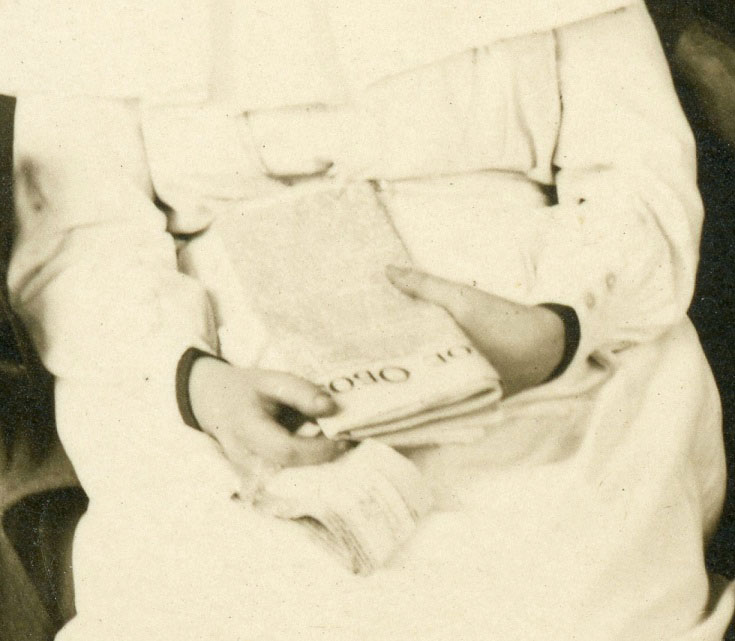
I read a long article online about Russian newspapers of the period, and none of the names matched the letters visible above. I then tried a Google image search of Russian newspapers of WWI, and one of them matched:

Рижское Oбозрение (Rizhskoye Obozreniye) translates as Riga Review. The paper was published in Latvia, which may explain why it wasn’t included in the article I read about the Russian press, although Latvia was part of the Russian Empire until 1918.
The newspaper indicates that the photo might have been taken in Latvia. Could it tell us anything else? I’m really curious about the men. My first thought was that they must be hospital patients, perhaps convalescing after serving on the front lines. But no bandages are visible, so I don’t think that explanation is correct. They’re all wearing basically the same outfit. Might they have been psychiatric patients? I wondered if they were prisoners. Then it occurred to me that they could have been prisoners of war.
Rigasche Rundschau
When I read about the history of the newspaper Rizhskoye Obozreniye, the POW theory made sense. The paper was founded in 1867 as Zeitung für Stadt und Land. In 1894 the name was changed to Rigasche Rundschau (Riga Review). Published in German, it catered to the large population of German speakers living in the area of Imperial Russia near the Baltic Sea (including Estonia, Latvia and Lithuania today). There were other German-language papers in other parts of Russia. However, during the First World War, publishing in the German language became illegal. The only way to continue publishing Rigasche Rundschau was to do so in Russian, which is what was done from 1915 until 1918. Publishing in German became possible in Latvia in 1918 and the newspaper continued to be published in Riga until the German-Soviet Nonaggression Pact of 1939 (the Molotov-Ribbentrop Pact), which stipulated that Baltic Germans were to be resettled to Germany from the area occupied by the Soviet Union.
There isn’t a Wikipedia page for the newspaper in English, but there are pages for it in German and in Russian.
Final thoughts
All the combatant armies of the First World War took large numbers of prisoners. In this case, the nurse might have been fluent in both Russian and German, and might have translated articles from the newspaper into German for the men. Other explanations might also make sense. For example, the men could have been Russian POWs in Germany, but I don’t know if a Russian nurse would have been able to visit them there. Let me know if you have any other ideas.
I titled this post “Light in the darkness” because journalism, at its best, shines the light of truth. In this photo, the nurse in her white uniform appears as a bright figure. To the men–whoever they were–she must have been a ray of hope in a dark time.


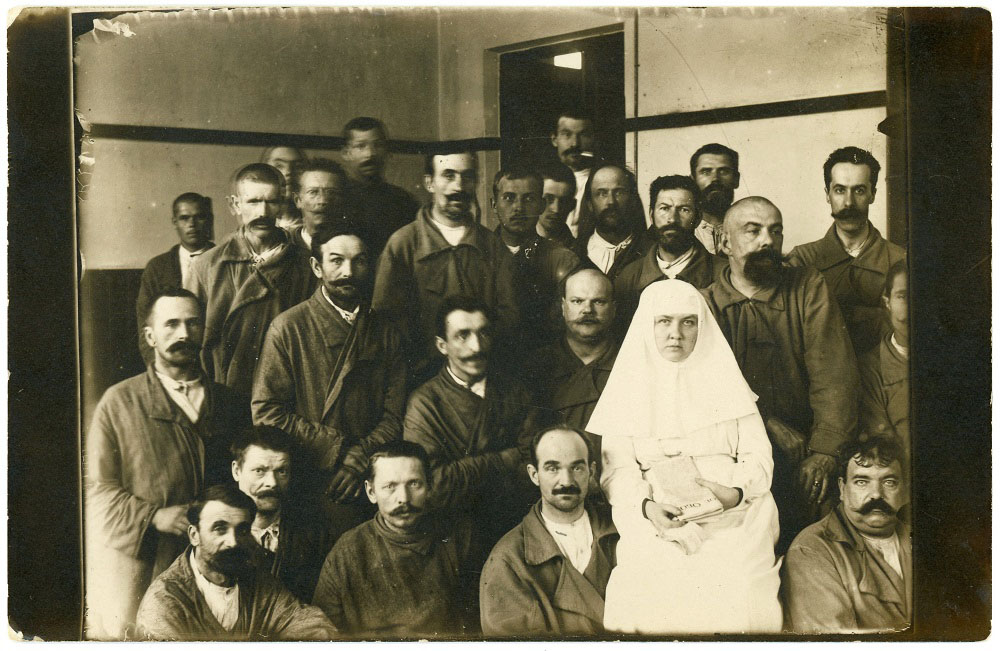
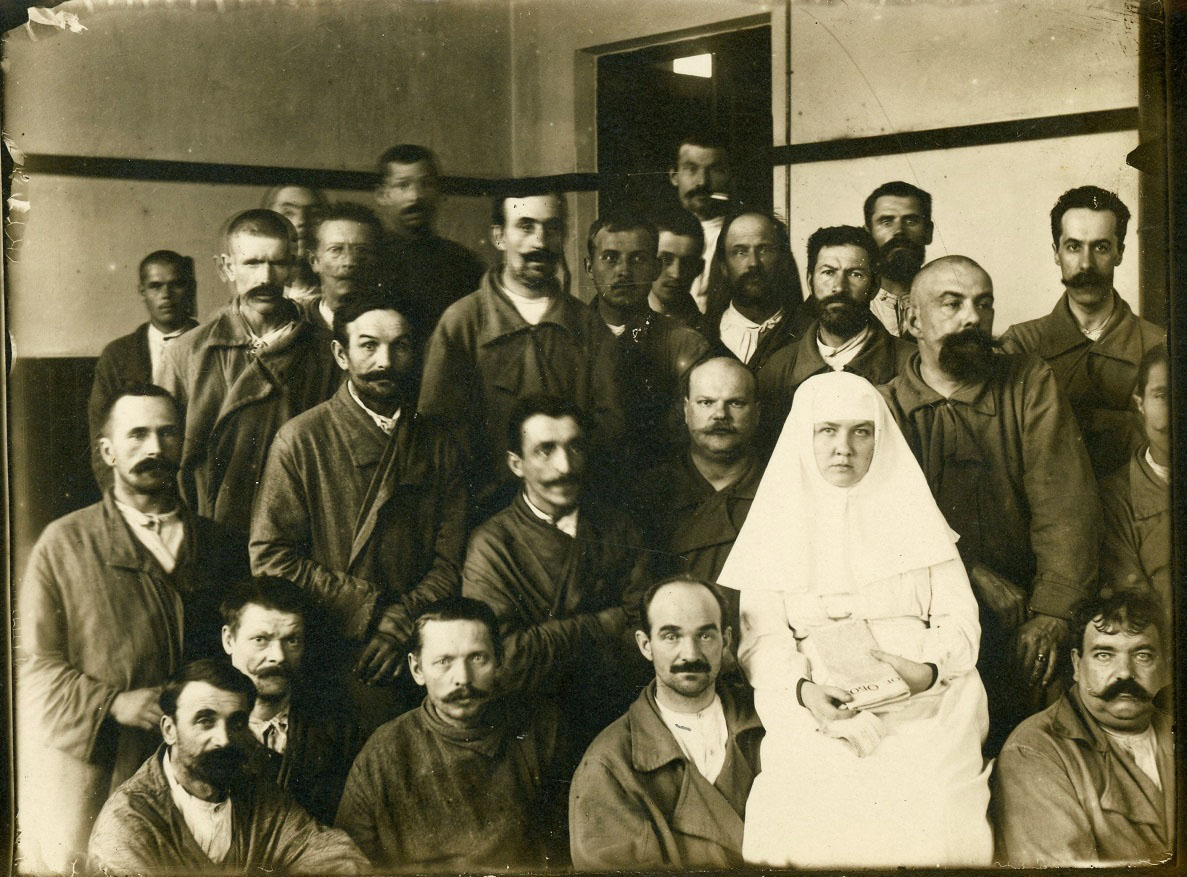
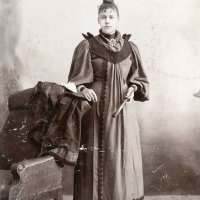
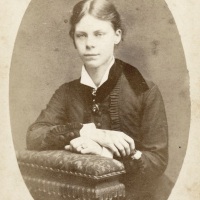
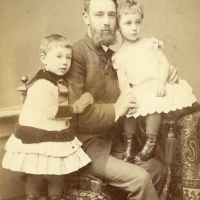
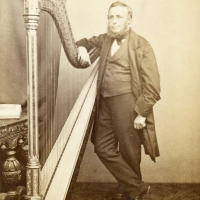
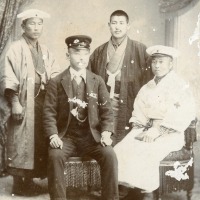
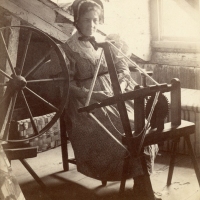
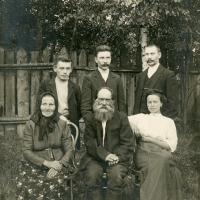
A really interesting story! Hopefully you will get some clues to the story behind the picture from a follower. Thank you for the post!
LikeLiked by 1 person
Thank you for reading and commenting, Michael!
LikeLiked by 1 person
Fascinating photo! I kind of doubt they are prisoners because I can’t see them being allowed to pose so casually.
LikeLiked by 1 person
One of the reasons for the photo might have been public relations. Still, I’d expect POWs to be photographed outdoors at a camp, rather than indoors, unless this was done in the middle of winter.
LikeLiked by 1 person
All that manly-man facial hair and one very brave nurse.
LikeLiked by 1 person
She seems pretty much at ease. Either she knows and trusts them, or she knows they wouldn’t dare do anything.
LikeLike
Because of the veil she wore around her face, I thought she was a nun. Without your research, I wouldn’t have guessed that she was a nurse. As you said, she appears to be the “Light in the Dark” amongst the men in a very difficult time.
You said so well, that “ journalism, at its best, shines the light of truth”. Can’t agree more. Just watched the film “Mr. Jones”, which tells the story of the welsh journalist, Gareth Jones, who sacrificed his life for bringing the truth to light in 1933.
Thanks for this insightful post, Brad.
LikeLiked by 1 person
Thanks so much, Isabelle! I hadn’t heard of “Mr. Jones,” but I’ll definitely see if it’s available here. Some journalists are incredibly brave!
LikeLiked by 1 person
The woman could be a nursing nun, but as for the men, complete mystery to me. The men look relatively healthy, sane and dressed as to preclude prison or even hospital. This is a real puzzler. Mental health issues might have prevented anything this organized. Could it have been a class picture of some kind? If language and translation were involved, they might have been emigres.
LikeLiked by 1 person
I hadn’t thought of a class. Interesting idea. The men do look healthy and well-groomed, but their uniforms look worse for wear. They could be emigres, refugees, deserters…. I hadn’t considered those possibilities. Thanks, Mary Jo!
LikeLiked by 1 person
You’re welcome!
LikeLiked by 1 person
I can feel the sadness in this photo. I’m thinking the men might have been psychiatric patients. Almost every man and the nurse have such a look of resignation.
LikeLiked by 2 people
I also thought the men might be psychiatric patients.
LikeLiked by 2 people
You can tell that this group had been through a lot. “Shell shock” was common in all the armies, along with other disorders. I see resignation in the nurse’s expression, but also toughness and determination to do whatever she had to do.
LikeLiked by 1 person
I’m very impressed by your research thus far, Brad!
LikeLiked by 2 people
Thank you, Liz! There’s a lot of literature about POWs in WWI, and I’ve only scratched the surface in my reading so far. The research possibilities are endless!
LikeLiked by 1 person
Wonderful! I await further developments on the research front.
LikeLiked by 1 person
That’s a very interesting ratio of coats to buttons! It looks like most of them are wearing double-breasted overcoats but either have them fastened oddly or simply wrapped over. Not one button to be seen. Yet many of the overcoats look like a standard pattern, like military issue but with buttons and other decorations removed.
On beards: most shaving at the time would have been done with straight razors. Psychiatric patients would have been shaved by staff and I can’t imagine any patient had access to the razor themselves. Some patients would have been essentially “ungroomable” if they resisted. This group looks fairly well groomed, and none totally unkempt. I doubt this is a psychiatric hospital.
All the men are of a military age, from 20 to 50. A psychiatric hospital would have a few older men
Also note the man sat behind the nurse has a ring (or two!) on his left hand ring finger. One seems to be a simple band, the other set with a stone.
LikeLiked by 1 person
Excellent observations, Emma. I agree about the men not looking like psychiatric patients for the reasons you mention, and about the coats looking like some kind of military issue. There’s a military connection here for sure. Isn’t it strange about the buttons! During the revolutions of 1917 and the Civil War that followed, insignia were often removed, but removing buttons wouldn’t make sense, unless they could be traded for cigarettes or something.
LikeLike
Amazing research, Brad. A fascinating picture. Everyone looks despondent.
LikeLiked by 1 person
Thanks so much, Carol. I agree that the atmosphere in this photo is pretty bleak. You can tell these were hard times.
LikeLike
Great mystery! Beautiful photo!
LikeLiked by 1 person
Thank you, Sherri! Even without knowing the story behind the photo, we can read so much from the faces. I wonder if sometimes we see the humanity even more clearly when we don’t know the details.
LikeLike
It is a rather sad photo as the nurse (I thought she was a nun) indicates that it is not a normal group. The men do look healthy but it is still odd to have that one woman there. If they were prisoners of war, as you said, it could have been for propaganda. The men’s faces are haunting. Good detective work on your part!
LikeLiked by 1 person
Thanks very much, Jo Nell. Propaganda is a distinct possibility, although to be fair, all the armies took pictures of POWs. The numbers of POWs throughout Europe were mind-boggling: 8 million total, with 2.4 million in Russia alone. Whoever these men were, they were unusual for some reason. I agree that the scene is haunting, made more so by the institutional setting.
LikeLike
I think this is a meeting of hard workers. They are wearing dressing gowns. This is the workwear of factory workers.And everyone’s eyes are either hungry or tired. This is probably a group of Bolsheviks. The photo was taken at the beginning of the 20th century. Let’s recall Chekhov’s aphorism of those years:
“A man without a mustache is like a woman with a mustache.”
Two men’s hands are visible-they are black.
The nurse seems to be from another photo and it creates the main intrigue. Maybe it’s a hospital for the rehabilitated. Although, I support the first version more. Thank you so much for such interesting puzzles!
LikeLiked by 1 person
They could be laborers, or they could be rehabilitated prisoners. Something about them is unusual or special. Also, the newspaper could be an accident, with no connection to the group, but I think the nurse would have hidden it from the camera in that case. Do you think the newspaper has any significance?
LikeLike
Good question about the newspaper. If to accept the fact that the newspaper in the picture is not an accident, then this group of people has adopted certain views. A newspaper published for the Germans, if I’m not mistaken. I am surprised that nothing shows the political affiliation of men. And it’s also strange that an “important” newspaper is held by a woman. Could she be a German woman? I wish I could find a solution.
LikeLiked by 1 person
I think this group of men, for some reason, doesn’t have access to newspapers, so she brought the news to them. Her choice of that particular newspaper, out of all the possible newspapers, tells us something about her or about them. But what is it?! 😜
LikeLike
I like the “shell shocked” theory, a group of soldiers recuperating from the horrors of war, maybe gassing, possibly the literal shocks to their brains of nearby blasts. They may have been living in a group setting, not necessarily a hospital but a large home or other structure commissioned as a recovery center. One wouldn’t expect them to be dangerous, nor to appear anything but “normal” on the outside, so posing with one nurse would be “safe.”
I found some quick references to Latvian Riflemen during WW1, especially during 1915-17. Might they be Latvian soldiers, who fought for the Tsar against Germany? My first thought on seeing the mustaches/beards was to think they were Russian men; I imagine Latvians sported similar facial hair styles at the time.
A fine mystery, with some truly great sleuthing on your part!
LikeLiked by 1 person
They could certainly be Latvians, or even Baltic Germans. I hadn’t considered those possibilities, oddly enough. The latter in particular would explain the newspaper! Your idea of a group recovery home makes perfect sense. I have a photo on the blog that was taken at one such home in Scotland, called Lennel House, where Allied officers could recuperate after service at the front. Records from Lennel House describe symptoms which we would recognize today as PTSD. Thank you for your insightful analysis, Rebecca!
LikeLike
This one really is a puzzler. The woman does look like a nun in many respects. As a group, the men do seem a bit on the old side for a group of soldiers. I’m more inclined to think it is a work group. A poor house perhaps, but what on earth could have prompted the occasion for a group photograph? Maybe they are political prisoners, not soldiers. This could be intended to show they are being treated well.
LikeLiked by 1 person
I feel pretty confident that one of the ideas put forward by you or another commenter is correct, but I don’t think we have quite enough clues to know which one. Probably the only way to know for sure would be to find another copy of the postcard, along with a description of it.
LikeLiked by 1 person
They all look so grave. And this highlights the important work of nurses then and now.
LikeLiked by 1 person
The work of nurses is incredibly important, especially during armed conflicts or public health crises, when nurses bear most of the burden of care.
LikeLike
Надеюсь, вы сможете прочесть мой комментарий по-русски. Отлично расследование о названии газеты. Мне кажется, что это все-таки русский лазарет. Судя по фотографиям того времени, одежда очень похожа https://humus.livejournal.com/4000406.html
LikeLiked by 1 person
Wow, so many interesting pictures! All from 1914, from various hospitals around Moscow. I see what you mean about the clothing. It does look very similar. Thank you so much for sharing that link! I look forward to exploring other pages on the site. Огромное спасибо!!
LikeLiked by 1 person
Very interesting! Both your research and all the comments really get one’s imagination going. It’s sort of amazing how a photo at first glance, seems pretty straight forward, but then opens up to so many possibilities! 😊
LikeLiked by 1 person
The previous commenter thinks the photo was probably taken at a military hospital, which was my first thought, but the first thought is often wrong…. It’s always fun to try to come up with other possibilities. 🙂
LikeLiked by 1 person
There’s one other possibility that I don’t think anyone’s mentioned: that the men might be workers or staff in an institution, and the nun/nurse their supervisor. During war, many civilian institutions are taken over for purposes other than those they were designed for. Could it be possible that a convent was being used as a hospital or something similar, and that the men were supplementing the staff? They just don’t have the look of psychiatric cases, POWs, or even soldiers on active duty. It might be worth poking around to see what convents or schools associated with religous orders were found around Riga.
LikeLiked by 1 person
That’s an excellent suggestion, Linda. They could be working as orderlies, in lieu of active duty at the front. Maybe they had already served at the front and been rotated to the rear for a period of service out of danger. (I don’t know if the Russian army did that, but it would make sense.) Whatever the case, the photo seems to indicate that they had a special relationship with this nurse. As you suggest, it could have been a working relationship.
LikeLiked by 1 person
I’m sure I’m totally wrong here, given the era but the nurse/nun almost looks like she has been photoshopped into the shot. The figure is so white – almost luminous compared to the white sections of clothing the men are wearing. I can’t see how the photographer could have achieved that effect. But also, she doesn’t appear to be sitting within the group – she’s sitting behind the front row of men and yet her skirts are in front. Almost like she’s sitting on the shoulder of one of the centre figures, front row. And the men don’t come across as being aware of her presence. There is clear perspective in relation to the various bodies and positions of the men but not of the woman. Perhaps it’s just me! Or could it have been possible to add her afterwards for propaganda purposes maybe? Forgive the intrusion – I really don’t feel qualified to mention these thoughts but…. !
LikeLiked by 1 person
Hi Sandra, technically it would be possible to add the nurse to the group of men by cutting her out of a different photo and then pasting her onto this one, but I think all that monkeying around would be obvious to us, especially at the level of magnification visible in the scans above. The group is well-lit, and I can almost guarantee that the nurse’s uniform is cleaner than the men’s shirts! I also brightened the scans just a little (3%) before posting them, to make the men in the back more visible. The nurse is probably sitting on a stool of some kind. The balding fellow sitting below her to the left (her right) may be holding her stool to keep it stable, because he’s sitting very close to her but not directly under her. In any case, thank you for offering such an interesting theory!
LikeLiked by 1 person
Cette photo cache beaucoup de mystères . J’ai pensé , avant d’avoir lu le résultat de votre recherche, que la femme était une religieuse . Je vois aussi des visages et des yeux en souffrances ou absents ( malades psychiatriques ? )
Merci pour ce partage et ce travail de recherche qui doit être passionnant !
Bon dimanche à vous .
LikeLiked by 1 person
Merci, Pierrette! My research was inconclusive, but Russian visitors to the blog have said that they think the photo was taken at a military hospital, and that the men were most likely Russian. I do enjoy investigating these old photos, even when the search doesn’t lead to a clear answer. Thank you so much for your thoughtful comments. Have a great week! Brad
LikeLiked by 1 person
Having carefully studied this photo (and in addition to your research, Brad) I have my own version that I would like to share. The men shown in the photo are closer to the European type in their type, on the right side most of them are clearly from Germany. Many men have a tense look. There are no bandages on their body, but there is one more reason why the prisoners of war could be in the hospital was gas attacks with chemical weapons from the Russian army. Most likely, these prisoners of war in March 1916 took part in hostilities from the side of the German army on the territory of Latvia in the Ikskülsky region bridgehead, which was then called “Island of Death” (a small peninsula in the bend of the Western Dvina). On March 21, 1916, the batteries of the 3rd Siberian Artillery Brigade of the 12th Army fired 576 chemical shells at German soldiers in the Ikskul area. These guys got a small dose of poisoning, so they were able to survive. Today Ikskul is the city of Ikskile. It is located on the right (eastern) bank of the Daugava River, 28 kilometers from the Latvian capital Riga. The nurse, most likely Russian, but fluent in German, who read and translated the last news from the front to the captured Germans, published in the newspaper “Riga Review” .
This is my version, maybe I am wrong. Brad, thank you very much for what you are doing. A photograph that seems simple in appearance is a carrier of very rare information about the events of the First World War.
LikeLiked by 1 person
Elena, your theory is fascinating! I find it very compelling. I also thought the men looked more German than Russian. In any group–Russian or German–there would likely be a few faces that looked typical for that group. In this group I see some faces that look typically German, but no faces that look typically Russian. Our opinion is subjective, of course, but the fact that you and I agree on this point is significant, I think.
I wish we could see the date of the newspaper. Your research into the fighting in Latvia in 1916 adds an important dimension to the analysis. If these men survived a gas attack, they would have considered themselves very lucky to be alive. Instead of this scene being a rather gloomy record of internment, it could be interpreted as a celebration of survival.
Thank you so much!
LikeLike
One more detail regarding this photo. The male collective in this photo can be roughly divided into two parts: on the right are several leaders of German origin, who unofficially lead the collective of this chamber. The left bloc for the most part consists of servicemen of the countries – allies of Germany, which were part of the quadruple alliance (Germany, Austria-Hungary, Turkey, Bulgaria.). This is my version. Maybe I’m wrong. Brad, thank you very much for what you are doing!
LikeLiked by 1 person
Very interesting analysis! There’s a man with dark features in the center of the group who is slightly blurry because he moved when the picture was taken. He doesn’t look Germanic or Slavic. He could possibly be from the Caucasus region, but if your analysis is correct, he’s much more likely to be Turkish.
Thank you for your additional comments, Elena! I value your perspective very much.
LikeLike